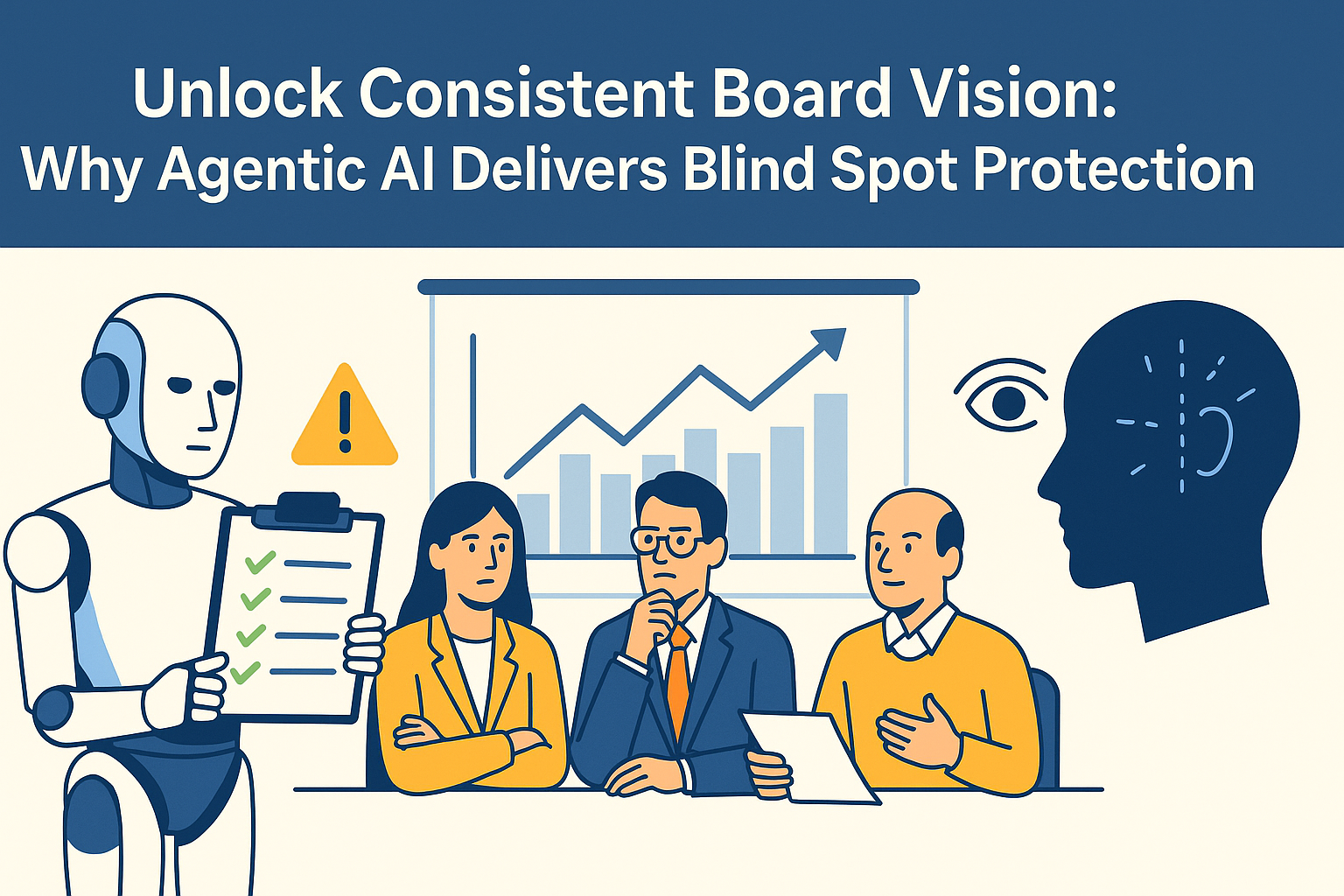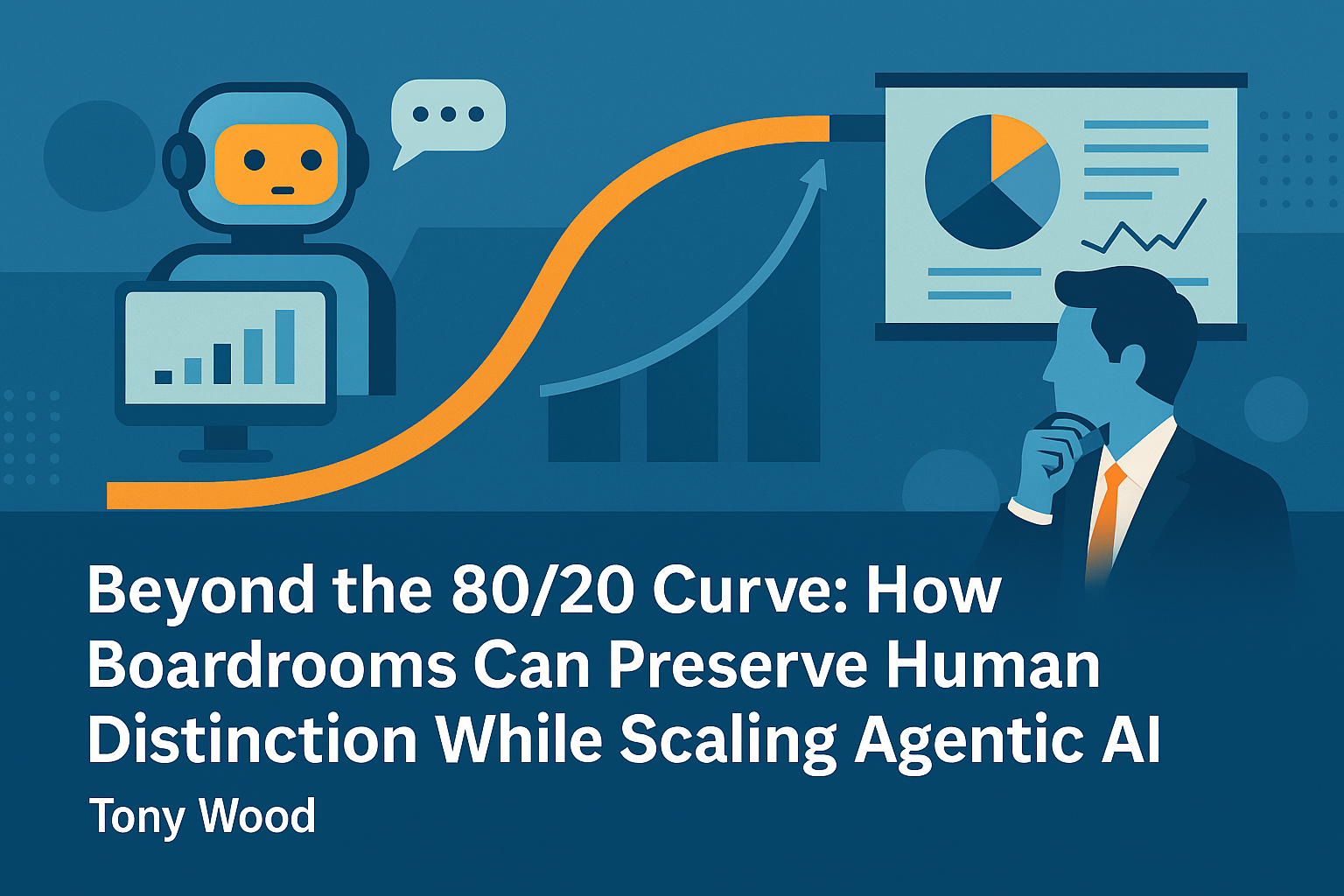
Beyond the 80/20 Curve: How Boardrooms Can Preserve Human Distinction While Scaling Agentic AI
Picture this: an AI agent builds a slide deck in six seconds, but it takes a human strategist six years to know which slide matters. Boardrooms everywhere are racing to harness agentic AI to drive productivity, yet a critical challenge is emerging how do we bank the speed of “good enough” automation, while protecting the costly, hard-won craft at the heart of premium brands?
This guide outlines a practical roadmap for senior leaders, bridging the chasm between efficiency and distinction in an agentic era.
The Emerging 80/20 Tension
Agentic AI can now perform 80% of most repeatable workflows capably and at breathtaking speed. The remaining 20% the nuance, the taste, the deep domain judgment—remains stubbornly human.
Recent Deloitte boardroom research highlighted the opportunity and the risk. “78% of senior execs report faster output from AI adoption, but only 11% see improvements in the kind of quality that sets brands apart.” In effect, output is scaling, but differentiation is blurring. The critical distinction sits in that last, stubborn mile.
As one leader shared, “The conscious mind confabulates reasons for decisions after the fact the real triggers are often subtle cues and context” (source), warning us that the gap between ‘done’ and ‘done right’ may widen as AI’s role grows.
Why Losing the Last-Mile Matters
• Apprenticeship gap: If entry-level work is largely automated, where will tomorrow’s experts and brand guardians emerge from? The ladder to the top risks being replaced by an elevator that skips essential floors.
• Taste decay: Enterprise value increasingly comes from the inimitable touch voice, feel, negotiation subtlety and experiential know-how. As Rory Sutherland remarks, “Customers don’t value things; they value their meaning” (source). Taste can’t be programmed: it’s developed, passed on, and easily eroded when process rules over craft.
• Economic inversion: As authentic expertise becomes rare, its price will rise. Brands risk either premiumising the “human touch” or losing access to it altogether if they don’t nurture their distinctiveness.
Mini-Case: Salesforce “Agentforce” Roll-Out
In 2024, Salesforce ran a landmark pilot deploying “Agentforce” agents into its marketing operations. Yes, campaign build times shrank by 30%. But in four close calls, AI outputs narrowly missed damaging brand context errors caught only thanks to experienced human review.
The executive board responded decisively: agentic tools would be paired with a ‘craft guild’ reskilling investment and new hybrid sign-off policy. Lifecycle time fell, but so did the risk of “brand blanding.” For high-touch clients, that human check was invaluable.
Governance Dashboard for Boards
How can boards steward both acceleration and expertise? Adopt a three-cluster KPI dashboard that blends speed with quality, reputation and talent:
• Speed & Cost: Track cycle time, agent productivity and cost-per-output.
• Human Distinctiveness: Measure brand Net Promoter Score (NPS), depth of expert bench, apprenticeship hours and customer perception of ‘brand feel’.
• Trust & Safety: Monitor hallucination rates, regulatory incidents and sentiment index across all stakeholders.
This KPI approach echoes recent guidance that “context is the most important thing in determining how people think, behave and act” (source). Brand and risk live where mere compliance dashboards cannot measure.
Board-Level Action Playbook
A. Map Your 80/20: Heatmap critical workflows by risk and differentiation. Where does “good enough” suffice—and where does your reputation or market price rely on nuance?
B. Codify Human-in-the-Loop: Build non-optional approval gates into agentic sequences at points where error = crisis. If in doubt, err on the side of excess review. Your brand is worth it.
C. Build a ‘Craft Ladder’: Reverse mentoring, micro-rotations, and AI guided simulation training can keep the expert pipeline alive, ensuring critical judgment is not a lost art.
D. Budget for Taste: Allocate funds for nuance preservation copywriting, product design, negotiation tactics, premium customer touchpoints. Consider it a R&D investment in competitive edge.
E. Continuous Model Refinement: Use structured feedback to spot where automated “better” is drifting into lowest-common-denominator “bland.” Be vigilant reputation decay is hard to reverse.
Future-Proof Questions for Your Next Board Meeting
- Which judgments and reviews in our core business lines cannot yet be safely automated?
- What is our ongoing mechanism for tracking apprentice and mid-level talent health as AI increases?
- Will our three-year investment in agentic tooling outpace, match, or lag our spend on preserving human expert capacity?
- Where could “rare craft” soon become the next pricing or loyalty differentiator, and are we ready to signal that scarcity?
“Speed can be bought; distinction must be grown. Neglect the soil, and no amount of agentic fertiliser will give you a rare bloom.” — Tony Wood, 2025
Links
- Salesforce Blog: “Future of AI Agents” • Trust: High • Reason: Up-to-date enterprise mini-case, directly referenced in mini-case section • 2024-12
- Deloitte: “AI Talent Paradox” • Trust: High • Reason: Boardroom data on apprenticeship and reskilling • 2025-03
Quotes
- “The conscious mind confabulates reasons for decisions after the fact the real triggers are often subtle cues and context.” (42courses.com) • Trust: High • Reason: Illustrates risk of over-automating nuance, supports argument for board oversight • 2024-07-27
- “Customers don’t value things; they value their meaning.” (42courses.com) • Trust: High • Reason: Highlights brand perception and human distinctiveness, aligns with section on taste decay • 2024-07-27

